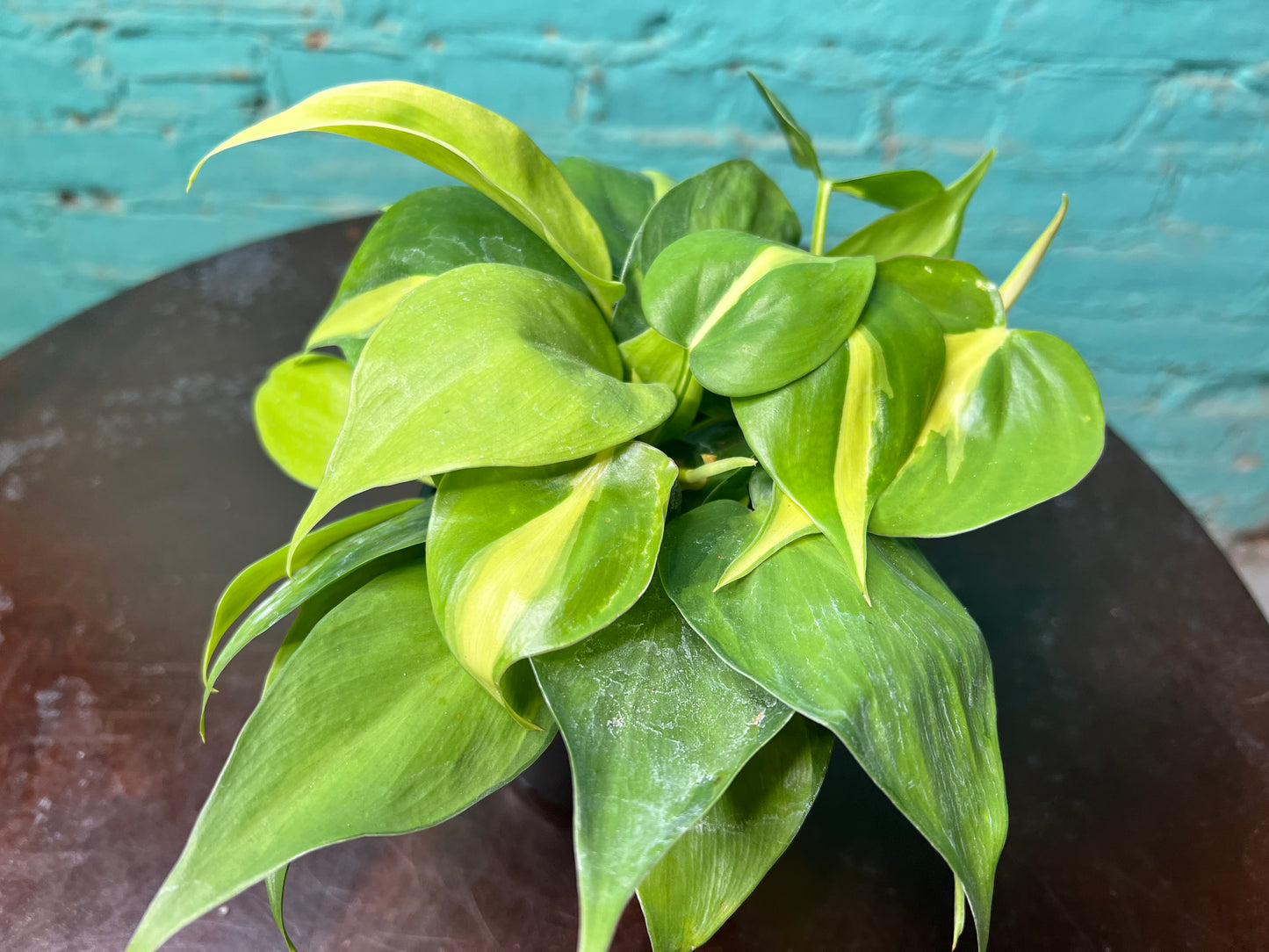The Rooted Plant Shop
Philodendron Brasil 4”
Philodendron Brasil 4”
Couldn't load pickup availability
Philodendron Brasil is a popular and attractive houseplant known for its vibrant, heart-shaped leaves with striking green and yellow variegation. It’s a cultivar of the Philodendron hederaceum species and is often grown as a vining plant. It’s a relatively easy-to-care-for plant, making it perfect for beginners or seasoned plant enthusiasts.
Care Guide for Philodendron Brasil:
Light:
- Bright, indirect light: Philodendron Brasil thrives in bright, indirect light. It will tolerate low light but may lose some of its vibrant variegation and grow more slowly. Too much direct sunlight can scorch the leaves, so it’s best to place the plant in a spot with filtered or indirect light.
- Ideal placement: Near a window with sheer curtains or in a well-lit room away from direct sun exposure.
Watering:
- Moderate watering: Water when the top 1–2 inches of soil feel dry to the touch. Avoid letting the soil stay soggy, as overwatering can lead to root rot.
- Allow soil to dry out slightly: Philodendron Brasil prefers to dry out slightly between waterings but doesn’t like to dry out completely for long periods. In the winter months, reduce watering as the plant’s growth slows down.
Temperature and Humidity:
- Warm temperatures: This plant prefers temperatures between 65–80°F (18–27°C). It can tolerate a range of temperatures, but sudden drafts or cold temperatures below 50°F (10°C) should be avoided.
- Moderate to high humidity: While Philodendron Brasil is adaptable to average household humidity, it will thrive in higher humidity (50% or more). If your home is particularly dry, especially in winter, consider using a humidity tray or a room humidifier.
Soil:
- Well-draining soil: Use a lightweight, well-draining potting mix, such as a peat-based mix with added perlite or orchid bark. This helps avoid waterlogging, which can cause root rot.
- Aeration: Philodendron Brasil enjoys a mix that allows air to circulate around the roots while retaining enough moisture.
Fertilizing:
- During the growing season: Feed with a balanced, water-soluble fertilizer diluted to half strength during the spring and summer months when the plant is actively growing. Apply once a month for optimal growth.
- Reduce feeding in winter: In the fall and winter, reduce fertilizing as the plant enters a period of slower growth and dormancy.
Potting & Repotting:
- Repot every 1–2 years: Repot when the plant outgrows its pot or if the soil becomes depleted of nutrients. Choose a pot that’s 1–2 inches larger than the current one, and ensure it has drainage holes to prevent water accumulation at the bottom.
- Avoid over-potting: Too large of a pot can result in excess moisture, so select a pot that allows for growth but doesn’t hold too much water.
General Care Tips:
- Support for vining growth: Philodendron Brasil is a vining plant, so you may want to provide a trellis, moss pole, or other support to encourage upward growth, though it can also be grown as a trailing plant.
- Pruning: Prune back any leggy or overgrown stems to maintain the shape of the plant and promote bushier growth. Cut just above a node to encourage new growth from that point.
- Cleaning leaves: Wipe the leaves gently with a damp cloth to remove dust and keep the plant looking glossy.
- Toxicity: Like many Philodendron species, Philodendron Brasil is toxic to pets (cats and dogs) if ingested, so keep it out of their reach.
Common Issues:
- Yellowing leaves: Yellow leaves can indicate overwatering, poor drainage, or too much direct sunlight. Make sure you’re watering correctly and that the plant is not exposed to harsh sun.
- Brown tips: Brown, crispy leaf tips are often a sign of low humidity or underwatering. Increase humidity levels or adjust your watering routine.
- Leggy growth: If the plant isn’t getting enough light, it can become leggy with sparse growth. Move the plant to a brighter spot to encourage fuller growth.
- Pests: Check the plant regularly for common pests like aphids, spider mites, or mealybugs. Treat infestations promptly with insecticidal soap or neem oil.
Share


Let customers speak for us
from 424 reviewsThe packaging was great. Everything safe and secure. Beautiful fully intact plant with a cozy heat pack.

This is my 2nd time purchasing an Alocasia Polly 4 1st time in the winter 😍 40 hour heat pack was surprisingly hot on arrival Superbly Packaged! Super healthy and pretty I’m so happy thank you

Loving it so far! It’s beautiful!

Do not hesitate! Add to cart and checkout, you won’t be disappointed. Mel is incredibly knowledgeable and has taught me so much, she doesn’t just sell plants she teaches and shows you how to keep them alive and thriving! I always receive my plants quickly, and most important - safely. Mel packages them with so much care, and ensures they will make the voyage okay! We are in the thick of winter in Wisconsin, and both times our heat pack was still warm and plants were good. And I haven’t even mentioned the quality, huge selection and amazing prices! One other thing worth noting is none of her plants will come with problematic pests like many bug box, ope I mean big box stores! Here are a few photos, I wish I could share more than 5.
This plant arrived healthy and beautiful in spite of below freezing tempertures outside. 😁

All of my plants arrived perfect and are so beautiful! Will be coming back.

Packaging was great!!! Plants arrived is great condition and heat pack was still a little warm.

She was delivered looking like perfection! She was packed beautifully. Mel is my new go-to for all my plants!

Plant arrived quickly and heathy Inspite of cold temps. Plant was wrapped and shipped with the utmost protection and care!!! The firefly is doing well in her new home!!!! Will purchase again from The Rooted Plant shop without hesitation!!








